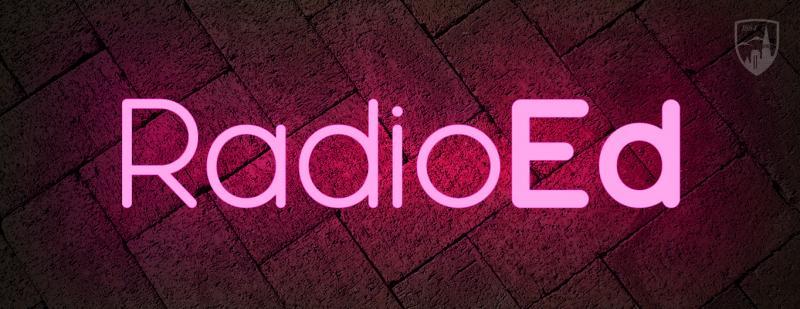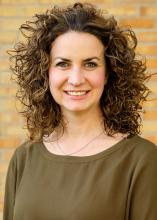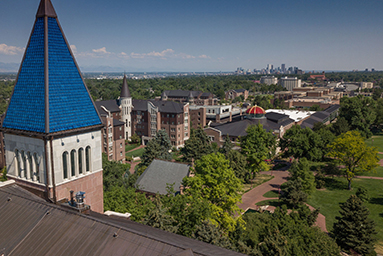Transcript
Intro, Nicole Militello: Welcome to RadioEd's first minisode. I'm Nicole Militello. Since the news is changing so fast these days because of the coronavirus, we wanted to start bringing you some bonus episodes in between our regularly scheduled content. So right now we're entering our third month staying at home because of the coronavirus, so we're recording this episode from our makeshift studios at home over Zoom. And while all of us are being encouraged to social distance, there are some places that that's just impossible, like prisons. They're hotspots for spreading the virus, especially since many prisons in the United States are overcrowded. In some states, 70% of incarcerated individuals tested are positive for the coronavirus. So today we're gonna talk about all of this with psychology professor Apryl Alexander. She just wrote a paper called, "Sick and Shut In: Incarceration During a Public Health Crisis."
Nicole Militello: Let's start with what makes prisons, especially in the United States hotspots for the coronavirus?
Apryl Alexander: Well, if you're familiar with any kind of correctional environment, it's really deprived of a lot of resources that we have in the real world. So correctional settings are often deprived, crowded, unsanitary environments, which just don't lend themselves to healing from things like a virus or illness. Thinking about just even the space—there's poor ventilation, poor circulation of air. In some facilities that I've worked in, we couldn't even have hand sanitizer because some individuals would get a hold of it, usually those who are mentally ill or who had cognitive deficits, and consume it. So we couldn't even have hand sanitizer to help protect yourself against illness. So that lack of resources and the nature of the facility really makes it a risk for people who are incarcerated to develop these health-related problems and not be able to heal properly from these problems. And a lot of folks who come into prison already have health problems just from living. A lot of these individuals may have been homeless prior to coming to prison. They may have had health-related problems due to lack of insurance while they were on the outside. They're already coming in as a vulnerable population and just more susceptible to illness. When you have Colorado prisons at 90% capacity, prevention techniques like physical distancing are just impossible to have in order to protect yourself from COVID.
Nicole Militello: Do you know what measures they are taking inside prisons to try to distance people or manage the virus?
Apryl Alexander: It's really hard and difficult to say. I don't know if we have a whole lot of information here in Colorado. Other states are trying to figure out ways to create some social distancing. So a lot of it is things that we don't like: limiting visitors, limiting some of the recreational activities that are going on inside. These are kind of resources that we would love for individuals to have, but during this time of COVID [we’re] reducing a lot of those activities in order to reduce the spread.
Nicole Militello: And so, like you said, being in a correctional facility, it's already marked by social deprivation. And then now with the coronavirus, we're kind of bringing it even to the next level, like you said, no visitors. What does that do for the psychology of incarcerated people or how they're managing being in prison?
Apryl Alexander: Sure, we know things like isolation and solitary confinement do result in a lot of adverse symptoms. So that has [an] impact on your psychological functioning, your cognitive functioning, and even the way in which you behave. So when we take away things like educational and social programming, we're creating further isolation [and] you might not have contact with your family members, as some prisons have reduced even phone and video calls. A lot of the prison services that are provided are faith-based, and so not having access to that can wear on a person's mental health. So we just need to be mindful of how isolation, which was already a problem in these settings is even more exacerbated during this time.
Nicole Militello: And this isn't really just a prison problem. What happens inside the prison is not just staying inside of the prison. So can you just talk a little bit about how that also does affect the local communities outside of prison walls?
Apryl Alexander: Sure, our ultimate goal is to reduce the spread of COVID. And so when we're looking at the prison environment, we have hundreds of staff who staff these facilities from day-to-day. [There are] hundreds of people who are going inside and outside of this environment each and every day, again, creating further exposure to the virus. So we have staff who are considered essential personnel due to the nature of their work, and we have to have staff in the prison. They are susceptible from encountering COVID on the outside and possibly bringing it inside a prison, which is causing this, again, great spread in correctional institutions. We've seen recently like Sterling Correctional Facility [in Colorado]—they have over 230 cases of COVID with just individuals who are incarcerated alone. That's not even counting the staff members who are susceptible and possibly taking this back to their communities and to their family members who can also be part of vulnerable or at-risk groups. One of the things that we've seen is also many of these prison personnel have not been given adequate PPE [Personal Protective Equipment] in order to minimize their exposure to the virus. so there's just a huge concern. If we're trying to protect the public, we need to figure out what our definition of that is. Protecting the public is also protecting our staff who have to come in and out of these facilities. Staff at correctional facilities are similar to our other healthcare workers, like nurses and doctors. They're doing this essential work, and we need to be mindful of how we protect them and protect our communities.
Nicole Militello: You wrote a whole paper on this recently, and I'm just curious what inspired you to share this message and why you're so passionate about it?
Apryl Alexander: Yeah, a lot of my work does center on creating a space and creating a voice for vulnerable populations. In my work, I've worked with both victims of interpersonal violence, and I've also worked with those who've perpetrated interpersonal violence, because many of those people have been victims themselves, whether that's victims of violence or victims of the system that has put them in their position. And so when COVID-19 came up, we were having a lot of conversations about the impact on our community. And I always think about how we define community? These individuals who are incarcerated are also part of our community. They were part of our community beforehand, and they're gonna be part of our communities in the future. 70% of people who are incarcerated are going to return back to our communities. So, if I'm thinking about creating safe environments and reducing the spread of COVID, I need to be thinking about these vulnerable individuals too, who are incarcerated. We have this tendency to often dehumanize people who are incarcerated, but I need people to really think about who is it that's incarcerated. A lot of people in our jails and prisons have severe mental illnesses. A lot of them have substance abuse disorders that they didn't have proper treatment for or proper access to treatment. And then here in Colorado, I think of the individuals who are still incarcerated for drug offenses. Marijuana is now legal, and we still have thousands of people who are incarcerated off of drug offenses that happened prior to the decriminalization of marijuana. So when I'm writing this paper, I'm thinking about all those individuals who are impacted by COVID but aren't front and center of the conversation. [I’m] thinking about our incarcerated individuals and other marginalized groups.
Nicole Militello: Some experts are recommending a process called smart decarceration. Can you just tell us what exactly does that mean, and what would that look like?
Apryl Alexander: Yeah, smart decarceration has been around for some time, but it's making a big buzz now. What it is, is really looking at how we transform policy, [and it’s] really aimed at reducing incarceration across the United States. We know that mass incarceration is a huge problem in the United States. The United States is the biggest hub for incarceration throughout the world, and what we've seen, once again, is there's a big movement for reform. A majority of Americans recognize that mass incarceration is a problem [and] that we're incarcerating too many people. We're recognizing that there are disparities in who we incarcerate, and one of the conversations we haven't had quite yet today is children are incarcerated. So smart decarceration is really aiming for evidence-based ways in which to think about how we eliminate disparities in the criminal justice system and how we reduce incarceration while still maintaining our goal of creating public safety and creating public wellbeing in centering the voices of victims. So again, taking a really critical look on, are there people that don't belong in prisons [or] in jail settings? So again, I speak of those individuals who are there for marijuana-related offenses. Do they still need to be there right now? The answer is no for so many different reasons. So, [I’m] thinking about [if there] are approaches that can reduce this issue of mass incarceration, reduce the racial, ethnic disparities in our criminal justice system, and then, in this conversation, reduce the spread of COVID.
Nicole Militello: Let's talk more about the young people. It's not just older people incarcerated, it's also younger people too. So how is this affecting them?
Apryl Alexander: Yeah, so we're seeing a wide spread of COVID in juvenile justice facilities as well. So, again, this is not just a problem that's affecting adults, but affecting our kids. I recently spoke to colleagues in a few other states, and there are kids who have gone six or seven weeks without speaking to their caregiver. Can you imagine what that would look like for a 12-year-old who's incarcerated, again, usually for a minor, nonviolent crime, not to have access to their loved ones for six to seven weeks? [They’re] still hearing this news—our kids who are incarcerated aren't isolated from the news, so they're hearing of people who are ill. They're hearing about people who are dying, and to not have contact with your family members again is contributing to that isolation and likely impacting their mental health. So when we're talking about smart decarceration and some of these other policies, we also need to center the voices of kids who are incarcerated as well because they're the most vulnerable, [and] they're the ones who are most isolated. If we're thinking about how we reduce re-offending or recidivism, this is gonna be critical in making sure that we address these kids and providing them with the appropriate resources, tools, and connections with their family members and communities in order to reduce recidivism because that's one of the things that is most effective is creating that sense of connection to your loved ones and community.
Nicole Militello: What lessons do you think that we've learned about the prison system in the United States from this coronavirus pandemic?
Apryl Alexander: I think the coronavirus pandemic has highlighted inequities across all systems throughout the United States. It's really highlighted educational inequities, the workforce inequities, the stop gaps in our medical system and, highlighted again, how we treat individuals who are incarcerated in the United States. If we are treating them like others, like not part of our community, then we're not going to dedicate the resources to them that will be protective of their needs. So, again, one of the things that we're thinking about in terms of smart decarceration is compassionate release. We have individuals in these correctional facilities who are aging, [and] the aging prison population is growing. We have individuals in there with terminal illnesses, individuals with severe mental illness. Again, what would it look like in order for us to release those individuals, especially the ones that have been rehabilitated who've made amends for their crimes, and place them back into their communities? You know, just a few weeks ago we had an 84-year-old man who died at Sterling Correctional Facility [in Colorado] due to COVID. Again, this was an individual who had dementia, renal failure, and a whole bunch of other medical problems. Smart decarceration would aim to resolve those inequities [and] create a system of fairness. I think that's the biggest lesson that we're learning with COVID. How do we create fair and equitable systems in order to alleviate these disparities during a pandemic? This pandemic has highlighted all sorts of disparities and inequities in our system, and I think once this is all resolved, I'm wondering what lessons are we gonna take for that and what are our next steps in making a more fair and equitable system for everyone, including our individuals who are incarcerated?
Nicole Militello: To read all of Apryl Alexander's paper, visit our show notes at du.edu/radioed. Be sure to subscribe, and thanks for tuning in to our first minisode. Alyssa Hurst is our executive producer and mixed our sound for this episode, James Swearingen arranged our theme, and Tamara Chapman is our managing editor. I'm Nicole Militello, and this is RadioEd.




